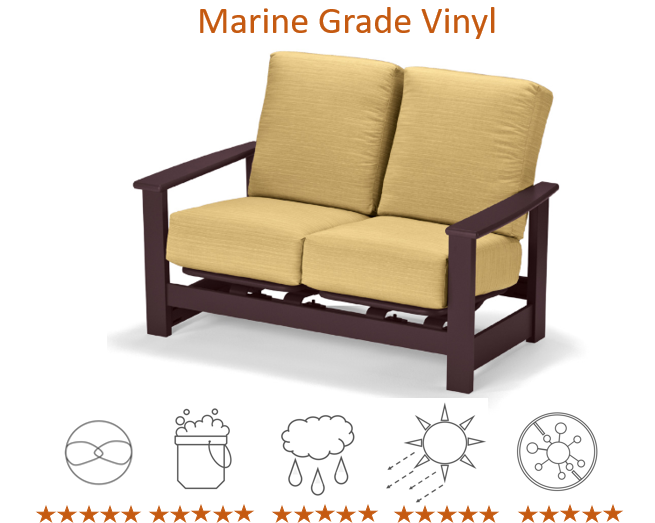Summer brings all kinds of opportunities to spend long days on the patio, at the pool or down at the beach. This is especially true this summer since we’re spending more time outside with friends and family than inside. #betteroutthanin
If you’re looking for answers on which fabrics to choose for your outside space, you’re in the right place.
I’m going to break down the top 4 outdoor fabric types and give you the low down on the durability, cleanability, water resistance, mildew resistance and UV protection for each.
Depending on your home turf, you’ll have all the information you need to make a solid buying decision whether you’re looking to purchase a full outdoor seating area or if you’re in the market for accents like pillows and curtains.
But before we get started on that, if you missed my two other patio/outdoor area posts, I’ll link them here:
Need options for an outside dining area for a small patio? Take a gander at Why a Round Table and Six Chairs is Perfect for Your Small Patio.
Or, if you need some inspiration to start an outdoor patio makeover, make sure you check out How to Create the Perfect Outside Oasis post form a couple weeks ago.
Both will get you cookin’ on starting points and inspiration.
Are you ready to find out what you need to know to pick the right outdoor fabrics?
Let’s get into it.
First let me show you a simple icon key for each fabric. Since outdoor fabrics have to do a bit more work than indoor fabrics, I’ll let you know how each stacks up in terms of being washable, water repellent, fade resistant and mildew resistant, etc.
Spoiler alert, each option will accomplish all of those things, but I’ll give you a star system to show you how they rate on a scale of 1 to 5 for each. Now this is my own system based on the research I did for this post. As with any purchasing decision, you should always do your own research. But, this should really help to narrow the type of outdoor fabric that will work for you.
Solution Dyed Acrylic Fabric
This means that the color pigment is added during the manufacturing process. The color goes all the way through the fabric, not just on the surface.
Source: Ballard Designs
It’s UV resistant without having to add anything else to it, ie: no topical solutions. From a comfort standpoint, it’s breathable which is important on hot sunny days, you won’t feel sticky or uncomfortable.
It’s water repellant which also makes it mildew resistant. So, you won’t have to worry about unsightly mildew spots or any unpleasant smell.
Solution dyed fabric is easy to clean. You can spot clean with soap and warm, not hot, water. If there’s a particularly soiled area, you can use bleach because the fabric is pigment dyed all the way through. You should, however; dilute 1 part bleach with 2 parts water and test it on an inconspicuous area.
Source: Outdura
The nice thing about solution dyed is that there’s a lot of colors and patterns to choose from.
Sunbrella fabrics is probably the most recognized solution dyed acrylic fabric brand.
Source: Ballard Designs
Solution Dyed Olefin
Much like solution dyed acrylic, solution dyed olefin is another durable outdoor fabric option. It’s quick drying – water repellent, sun and fade resistant and it will not mildew.
Outdoor olefin fabric is usually less expensive than acrylic fabric, but that will also depend on the furniture manufacturer or brand of furniture you’re purchasing. However, if you are only purchasing fabric to diy your own cushions, you should see the cost difference.
Source: Patio Lane
If you’ve shopped for stain resistant interior furniture, you may have encountered terms like polyolefin, polypropylene or polyethylene. These are olefin fabrics and they hold up great to busy households. The fibers are super strong and are ideal for outdoor use.
Source: Wayfair
Olefins are also pigment dyed all the way through which will provide color fastness and UV protection from fading.
The main difference between the two is olefin has a slightly rougher, waxy texture. Acrylic has a softer feel than olefin.
For cleaning, you should use a mild detergent and warm water. You can soak it and use bleach on olefin but, use the 1 parts bleach to 2 parts water solution as with acrylic.
Olefin is not flame resistant so, campfires and open flames are not its friend. It will melt when approaching 300 degrees Fahrenheit. Also, be careful of oils and grease as they can set in and stain olefin when not cleaned right away.
Compared to acrylic fabrics, olefin will hold up better to heavy use or abrasion, but acrylic is slightly better for water resistance. So, poolside or beach front, acrylic is the way to go. If you’re looking to update your patio or deck, olefin should do just fine.
PVC Polyvinyl Chloride Mesh
PVC is the most commonly used material in the world. It’s made from plastic. Polyester yarn is extruded with vinyl (PVC) to form a mesh that is woven from each individual yarn. It’s strong and durable.
Most of the time you’ll see PVC fabric on sling chairs. This is because the fabric is supportive and strong and will not sag.
If you live in a climate that gets extreme shifts from cold to hot, PVC is great because it won’t be compromised by freezing or high atmospheric temperatures. The main differences between PVC and olefin and acrylic fabrics is, PVC is more ridged and is definitely an outdoor fabric. Olefin and acrylic can be styled and used in 3 season sunroom or even as main interior furniture as well. PVC is specifically suited for the open outdoors.
You can scrub PVC and clean it with oxygen bleach, and it won’t effect the strength or color. Just give it a good rise to make sure the detergents you use are off it completely before sitting on it.
Leaves and debris will easily sweep off, so quick cleaning is a breeze.
Source: Sears
Marine Vinyl
This fabric is a combination of PVC and polyester. It’s a great option for seaside furniture. If you live near the ocean, it should hold up great to salt air and water.
It’s different than regular vinyl. Marine vinyl has UV protection to make it sun and fade resistant. It also has additives that make it anti-microbial, anti-fungal, so no mildew either.
You should be able to clean the vinyl with some warm water and dish detergent. Tough stains may require a bit more elbow grease, but it’s not good to use abrasive cleaners or bleach. So, scrub with a soft bristle brush and some pressure and you’ll get good results.
It will stand up to heavy water and sun for up to 20 years and is quite strong. It should hold up to bumps and wear well, however it is not puncture proof so be care with sharp items like cutlery, scissors or tools.
It’s the most durable outdoor fabric, especially compared to acrylic, olefin and PVC mesh. It is also not as breathable as the other options, so sitting on marine grade vinyl for long periods of time on hot days will definitely leave you wanting to jump in the pool to cool off.
Source: USA Outdoor Furniture
Which Outdoor Fabric is Best for Accents?
If you want outdoor pillows and curtains, you want to use solution dyed acrylic because these will give you an indoor feel with outdoor resiliency. This is especially key if you’re looking to decorate your patio space like an interior room.
Source: Sunbrella, Wayfair
You’ll find ready made options in a lot of big box stores and on websites like Etsy if you want something a bit more custom.
For outdoor curtains, the best outdoor material is solution dyed olefin. It’s going to give you the most UV protection and soft hand for patio curtains, outside gazebos and shade structures. There’s tons of colors and patterns to choose from. You can easily find it online or at many fabric stores.
Source: Wayfair
There you have it, what you need to know to pick the right outdoor fabrics. If you’ve found this post helpful, make you’re you click the like button or share it out with your friends.
Thanks so much for stopping by. Now go and decorate that patio space and enjoy the summer weather!
Join the Fun!
If you enjoyed this post and you want to keep seeing my weekly blog, the best way to do that is to subscribe.
You can subscribe by downloading my 11 Secrets Only Designers Know to Make Your Space Rock. If you’re curious about how decorators and designers make a home look magazine ready, you’ll love taking a gander at these 11 secrets. You’ll learn how to style your room from the floor up and it will work for ANY space you have.
I write about small space design and decorating, sustainable furniture options, positive self care and a variety of do-it-yourself home décor.
I’d love to connect with you!
“This man is a plant shaman. He not only designs beautiful rooms, he’s got a green thumb that works like magic! My peace palm never looked better.”
“Michael Helped me to get my home office in magazine ready form. Thank you a million times for helping me figure this room out. It’s now my favorite room!”
Michael is Principal designer and blogger at Michael Helwig Interiors in beautiful Buffalo, New York. Since 2011, he’s a space planning expert, offering online interior e-design services for folks living in small homes, or for those with awkward and tricky layouts. He’s a frequent expert contributor to many National media publications and news outlets on topics related to decorating, interior design, diy projects, and more. Michael happily shares his experience to help folks avoid expensive mistakes and decorating disappointments. You can follow him on Pinterest, Instagram and Facebook @interiorsmh.



















